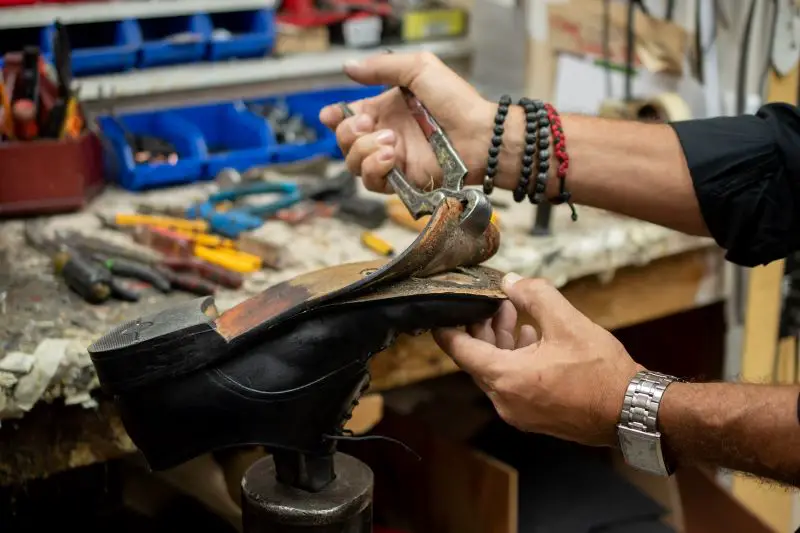Those who wear boots know that nothing lasts forever. Over time, the soles of your boots wear out and need to be replaced. Reupholstering boots is a common practice, especially if the leather on the upper is still in good condition.
Sole reupholstery is a cost-effective way to maintain the functionality of your boots for the long term. However, the question arises as to whether it is possible to resole a partially welted boot. This essay discusses the concept of welted soles and whether it is possible to resole the soles of partially welted sole boots.
The answer to this question is Yes, boots with partial welt soles can have their soles reupholstered. However, the process of resoleing a partial welt sole boot is more complicated than that of a full welt sole boot.
The lack of welts on the sides of the sole makes it more difficult to install a new sole, so a different approach is required.
In this article, we’ll tell you everything you need to know about resoleing partial welt sole boots.
What are Partial Welt Sole Boots?
A partial welt sole boot is a type of boot construction in which the welt does not extend around the sole. Instead, the welt only exists on the front and back of the boot, leaving the sides of the sole exposed.
This style of construction is often found in dress shoes and boots as it provides a smoother appearance and allows more flexibility in the sole.
Partial welt sole boots, also known as half welt boots, are a type of footwear with a partial or partial welt sole. Half welt that runs along the outer edge of the solenot all around the shoe,
A welt is a strip of leather or synthetic material sewn between the upper and sole of a shoe to give strength and durability to the structure of the footwear.
Partial Welt Sole Boots are a popular choice for those looking for a durable and reliable boot. work or casual.
A partial welt construction provides the strength and durability you need without adding unnecessary weight or bulk to your shoe.
This makes it a practical and comfortable option for those who want a work boot that is lightweight and flexible yet provides the protection and support their work requires.
One of the main advantages of partial welt sole boots is that they are easier and more cost effective to repair than full welt boots.
If the sole is damaged or worn, only the partial welt and sole should be replaced, not the entire shoe. This makes partial welt sole boots a more sustainable and eco-friendly option as they can be repaired and reused for years.
Partial welt sole boots come in a variety of styles, including lace-up boots, Chelsea boots, and chukka boots.
A variety of materials are also available, including leather, suede, and synthetic materials. Your choice of material depends on your desired level of durability, flexibility and style.
When choosing partial welt sole boots, it is important to consider the intended use of the shoe, the quality of construction and materials.
Look for boots with sturdy soles, good traction, and comfortable insoles. It’s also important to consider the fit of the boot. Well-fitting shoes provide the support and comfort you need for long-term wear.
Partial Welt Sole Boots are a reliable and practical option for those who need a durable and comfortable work or casual boot. Partial welt construction provides the strength and durability you need while remaining lightweight and flexible.
Their sustainability and ease of repair make them a smart choice for those seeking a long-lasting eco-friendly shoe option.
How do I replace the sole of a partial welt sole boot?
To replace the sole of a partial welt boot, the old sole must first be removed. This process cuts away the old sole and the glue and stitches that hold it in place. The upper leather and remaining welt are then washed and prepped for a new sole.
A new sole must then be selected and cut to fit the shape of the old sole. Once the new sole is cut, attach it to the upper leather and remaining welt with glue or stitch.
The process of resoleing partial welt boots is more complicated than full welt boots. The lack of welts on the sides of the sole requires a more delicate approach, and the process of installing the new sole requires more attention to detail.
However, with the right tools and expertise, you can resole partially welted boots to extend their life.
Reupholstering a partial welt boot is not as difficult as you might think. With a few basic tools and materials, you can restore your favorite boot to its former glory. To resole a partially welted boot, follow these steps:
Step 1: Collect Materials
To start reupholstering the sole, you’ll need a few materials. These include:
New sole: For a better fit, choose a sole that is the same thickness as your current sole. Replacement soles are available at shoe repair shops or online.
Boot knife or sharp scissors: You’ll need to cut off the old sole to fit the new sole.
Rubber cement: This is used to attach the new sole to the boot.
sandpaper: Use sandpaper to roughen the surface of the old sole for better adhesion of the new sole.
hammer: The new sole needs to be hammered into the boot for a tight fit.
Cone: Use an awl to make a new hole in the leather to sew the new sole onto the boot.
Step 2: Remove old soles

Carefully cut the old sole from the boot using a boot knife or sharp scissors. Remove the old sole and any remaining adhesive.
Step 3: Polish the surface
Use sandpaper to roughen the surface of the old sole where the new sole will be applied. This will help the new sole adhere to the boot.
Step 4: Apply rubber glue

Apply a thin layer of rubber cement to the surface of the old and new soles. Allow the cement to dry for a few minutes before attaching the new sole to the boot.
Step 5: Drive the new sole into the boot
Carefully attach the new sole to the boot using a hammer. You have to press firmly to get a good fit.
Step 6: Sew New Sole to Boot

Use an awl to make a new hole in the leather to sew the new sole onto the boot. The new sole is then sewn onto the boot using strong thread. Tighten the thread tightly to achieve a tight seam.
Step 7: Trim Excess Sole
Once the new sole has been installed and sewn into the boot, use a boot knife or sharp scissors to trim the excess sole from the edge of the boot.
Reupholstering a partial welt sole boot is a relatively simple process that can be done at home with the right tools and materials.
With patience and attention to detail, you can extend the life of your favorite boots and keep them looking and feeling great for years to come.
In addition to the technical aspects of partial welt sole boot resoles, it is essential to consider the cost-benefit analysis of boot resoles.
The cost of resoleing a partial welt sole boot can be higher than for a full welt sole boot due to the additional effort and complexity involved.
However, the cost of reupholstering a boot is significantly less than the cost of purchasing a new boot. Reupholstering your boots also helps reduce waste and promote sustainable consumption habits.
summary
In conclusion, partial welt boots can be resoleed, but the process is more complicated than full welt boots. Reupholstering your boots helps extend the life of your boots, reduces waste and promotes sustainable consumption habits.
When considering whether to resole a boot, it is imperative to consider a cost-benefit analysis and seek out a skilled shoemaker who can perform the necessary repairs. With proper care and attention, your boots will last for years.


